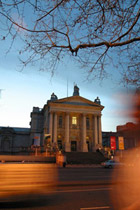|
 Work No. 850 centres on a simple idea: that a person will sprint as fast as they can every 30 seconds through the 86 metre gallery at the heart of Tate Britain. Each run is followed by an equivalent pause, like a musical rest, during which the gallery is empty.
Bill Ruprecht, President and CEO of Sotheby's, said: "Sotheby's is delighted that our sponsorship has enabled Tate Britain to make the Duveens Commission an annual event for three years. Showcasing the work of talented artists of their choice is what has made Tate one of the world's most widely-visited arts institutions." Work No. 850 centres on a simple idea: that a person will sprint as fast as they can every 30 seconds through the 86 metre gallery at the heart of Tate Britain. Each run is followed by an equivalent pause, like a musical rest, during which the gallery is empty.
Bill Ruprecht, President and CEO of Sotheby's, said: "Sotheby's is delighted that our sponsorship has enabled Tate Britain to make the Duveens Commission an annual event for three years. Showcasing the work of talented artists of their choice is what has made Tate one of the world's most widely-visited arts institutions."
Vitality
Creed's Work No. 850 is the latest in an ongoing series of contemporary sculpture commissions in the Duveen Galleries at Tate Britain, which now, through the support of Sotheby's, is an annual event. Previous contributors to the biennial event included Mark Wallinger (2007), Michael Landy (2004), Anya Gallaccio (2002) and Mona Hatoum (2000). The series builds on a long tradition of exhibitions in the Duveen Galleries, which has included memorable installations by Richard Long, Richard Serra and Luciano Fabro.
 The work, says Tate, is about the purest expression of human vitality: "This investigation into the body celebrates physicality and the human spirit, the constant ebb and flow of nature. Work No. 850 presents the beauty of human movement in its purest form, a recurring yet infinitely variable line drawn between two points".
This new work extends Creed's career-long investigation into physical experience and everyday life and relates to The work, says Tate, is about the purest expression of human vitality: "This investigation into the body celebrates physicality and the human spirit, the constant ebb and flow of nature. Work No. 850 presents the beauty of human movement in its purest form, a recurring yet infinitely variable line drawn between two points".
This new work extends Creed's career-long investigation into physical experience and everyday life and relates to
|
|

other works the artist has made exploring basic human activity depicting vomiting, Work No. 503 (2006), defecating, Work No. 600 (2006) and sex, Work No. 715 (2007). As with previous art works and music by the artist, rhythm and order are integral to this piece. The pace echoes the rhythm of Creed's renowned Work No. 227 The lights going on and off (2000) displayed in his Turner Prize exhibition in 2001.
Movement
Martin Creed said: "I like running. I like seeing people run and I like running myself … running is the opposite of being still. If you think about death as being completely still and movement as a sign of life, then the fastest movement possible is the biggest sign of life. So then running fast is like the exact opposite of death: it's an example of aliveness."
Creed's idea for the work stems from a trip to the catacombs of the Cappuccini monks in Palermo, Italy. Arriving at the crypt just before closing time, Creed and his companions had only five minutes to see the museum and were forced to run around the space looking desperately left and right at all the dead bodies displayed on the walls, trying their best to see it all.
|

